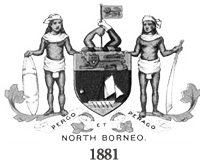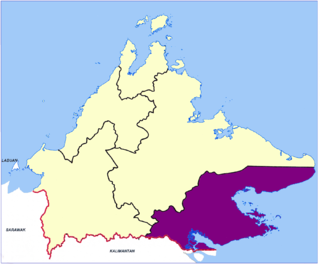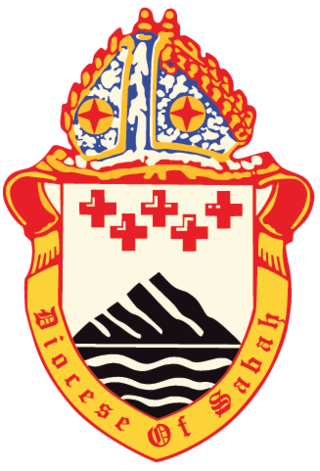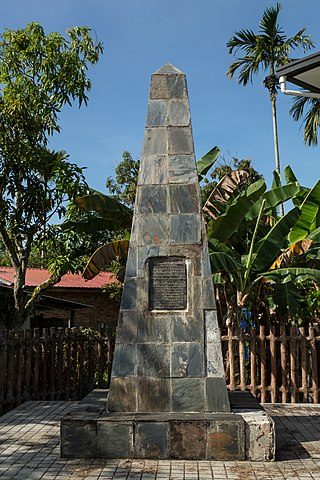
The British North Borneo Herald was a periodical magazine in British North Borneo, published between 1883 until 1941 by the government of North Borneo under various official names.

The British North Borneo Herald was a periodical magazine in British North Borneo, published between 1883 until 1941 by the government of North Borneo under various official names.
After the entry into force of the Royal Charter for the North Borneo Chartered Company on 1 November 1881, the company faced with the task of creating a functioning governmental structure for the acquired territory. The resolutions passed by the Court of Directors, the highest administrative body of the company in London, required efficient distribution within the administrative units in North Borneo as well as among the shareholders and investors of the company. For this reason, the first sixteen-page edition of the periodical "The North Borneo Herald and Official Gazette" appeared on 1 March 1883, in Kudat, the first capital of North Borneo. [1]
For the monthly publication of the newspaper and the printing in the Dent Road no. 1, Thomas J. Keaughran, [note 1] a former reporter of The Straits Times was responsible. [2] The single price was 10 cents, while the annual subscription was 1.50 Straits dollar. [1]
In 1883, Sandakan was raised as the new capital instead of Kudat, and this herald moved their place of publication to the new administration area. [3] The editorial and printing from 1885 to 1891 were by W. J. Rozario. [4] From 1 January 1896, the herald turned into a four-day appearance. The price per issue was still 10 cent, while the annual subscription including postal delivery increased to 2.50 Straits dollar.
The last edition appeared in 1941. Following the Japanese occupation in January 1942, especially when the Japanese marched into the town of Sandakan on 19 January; the journalistic activities were forbidden with immediate effect. The end of the operation under the North Borneo Chartered Company on 26 June 1946 also sealed the fate of the Herald, while the Official Gazette continued to exist as a memorandum of the British colonial government until 1963.



Although the herald is usually quoted as British North Borneo Herald, its official name has undergone several minor changes:
In accordance with the intention of a governmental news organisation, legislative texts and ordinances had been part of the herald from the very beginning. Even in the edition of the herald on 1 April 1885, these were printed in a separate section of the "Gazette". A section "Official Gazette" was established for the editions from 1 May 1885 to 1891. [4] After that, the British North Borneo Official Gazette was continued as an independent governmental advisor.
As a governmental report, the herald was not a neutral source as it did not publish any information that was detrimental to the image of the North Borneo government (in the form of the Court of London) or to the share price of the North Borneo Chartered Company. In none of these accounts are there any comments on the trench battles between William Clark Cowie and the highly popular Governors Hugh Charles Clifford and Ernest Woodford Birch, who led in both cases the resignation of the governor. Also the inadequacies of the North Borneo Railway, the catastrophic misjudgment regarding the manganese deposits at Marudu Bay in 1907 and the big fire, which destroyed the sawmill of British Borneo Timber in 1934, were not mentioned.
Herald's archival editions are now available in various libraries in Asia and Europe. Among the periodicals, the herald, together with The Straits Times and The Singapore Free Press and Mercantile Advertiser (1884–1942) is the most important source of knowledge for the history research on North Borneo and the North Borneo Chartered Company.
Comprehensive original editions of the herald are in the Sabah State Archives, The National Archives, Kew and the Singapore National Library. [5] [6] However, in contrast to other magazines, the British North Borneo Herald is not digitally developed for public use.

North Borneo was a British protectorate in the northern part of the island of Borneo, which is present day Sabah. The territory of North Borneo was originally established by concessions of the Sultanates of Brunei and Sulu in 1877 and 1878 to a German-born representative of Austria-Hungary, a businessman and diplomat, Gustav Overbeck.

Kudat is the capital of the Kudat District in the Kudat Division of Sabah, Malaysia. Its population was estimated to be around 29,025 in 2010. It is located on the Kudat Peninsula, about 190 kilometres (120 mi) north of Kota Kinabalu, the state capital, and is near the northernmost point of Borneo. It is the largest town in the heartland of the Rungus people which is a sub-ethnic group of the majority Kadazan-Dusun race and is therefore a major centre of Rungus culture. It is also notable for being one of the first parts of Sabah to be settled by Chinese Malaysians, particularly from the Hakka dialect group. It is the Northernmost Malaysian city.

Sandakan formerly known at various times as Elopura, is the capital of the Sandakan District in Sabah, Malaysia. It is the second largest city in Sabah after Kota Kinabalu. It is located on the Sandakan Peninsula and east coast of the state in the administrative centre of Sandakan Division and was the former capital of British North Borneo. In 2010, the city had an estimated population of 157,330 while the overall municipal area had a total population of 396,290. The population of the municipal area had increased to 439,050 by the 2020 Census.

The North Borneo Chartered Company (NBCC), also known as the British North Borneo Company (BNBC) was a British chartered company formed on 1 November 1881 to administer and exploit the resources of North Borneo. The territory became a protectorate of the British Empire in 1888 but the company remained involved with the territory until 1946, when administration was fully assumed by the Crown colony government.

Kudat Division is an administrative division in the state of Sabah, Malaysia. It occupies the northern tip of Sabah. Its total area of 4,623 square kilometres makes it the smallest of the five divisions of Sabah. The division covers the districts of Kudat, Pitas and Kota Marudu, as well as the islands of Balak, Balambangan, Banggi, Bankawan, Guhuan Utara, Kalampunian and Malawali.

Tawau Division is one of the five administrative sub-divisions of Sabah, Malaysia. It occupies a total of 14,905 square kilometres or 20% of Sabah's territory. The main towns include the capital of Tawau, Lahad Datu, Kunak and Semporna. Tawau division has 26% of Sabah's total population, with the main indigenous groups consisting of the Bajau, Suluk, Ida'an, Tidong, Cocos, Murut, Lun Bawang/Lun Dayeh as well as a minority of mixed ethnic groups. Large numbers of both legal and illegal immigrants from Indonesia such as the Buginese and Torajans, from East Timor the Timorese, from the Philippines the Tausūg and Visayans as well South and West Asian immigrants such as Pakistanis, Indians and Arabs can be found in this area. As with the rest of Sabah, the division also has large numbers of ethnic Chinese.

Sandakan Division is an administrative division of Sabah, Malaysia. It stretches diagonally from the northeastern coast of Sabah to the state's central region. With an area of 28,205 square kilometres, it occupies 38.3% of Sabah's territory, and is thus the largest of the five administrative divisions of Sabah. It also has approximately 19.4% of Sabah's total population, with the major inhabitants comprising the Chinese, Orang Sungai, Kadazan-Dusun, Suluk and Bajau Simunul.

West Coast Division is an administrative division of Sabah, Malaysia. It occupies the northwest portion of Sabah. With an area of 7,588 square kilometres, it occupies 10.3% of Sabah's territory. It also has approximately 30% of Sabah's total population, with the main indigenous inhabitants comprising the Bajau, Bisaya, Bruneian Malay, Dusun, Illanun, Kadazan and Kedayan, as well with a significant numbers of Chinese. The division is divided into the districts of Ranau, Kota Belud, Tuaran, Penampang, Papar, and the state capital Kota Kinabalu. The main towns are as in the names of the districts, plus other towns including Putatan, Inanam, Telipok, Tamparuli, Tenghilan and Kinarut.

The Interior Division is an administrative division of the state of Sabah, Malaysia. It occupies the southwest portion of Sabah, bordered by the neighbouring state of Sarawak on its west. With an area of 18,298 square kilometres, it covers 24.9% of Sabah's territory and is home to approximately 14.7% of Sabah's total population. The largest town in the Interior Division is Keningau. Other main towns in this division include Beaufort, Kuala Penyu, Sipitang, Tambunan and Tenom.

The Diocese of Sabah is an Anglican diocese which covers Sabah and Labuan in Malaysia. Founded in 1962, the see was originally part of the much larger Diocese of Labuan and its Dependencies which was established in 1855. Following the carving out of the Diocese of Singapore in 1909 from this last ecclesiastical territory, the area of the present-day Diocese fell under the jurisdiction of the Diocese of Labuan & Sarawak, which was reorganised as the Diocese of Borneo in 1949. In 1962, the latter diocese was divided into two, forming the Diocese of Kuching and the Diocese of Jesselton, which was renamed the Diocese of Sabah when the capital city was given the new name of Kota Kinabalu in 1967.

The history of Sabah can be traced back to about 23–30,000 years ago when evidence suggests the earliest human settlement in the region existed. The history is interwoven with the history of Brunei and the history of Malaysia, which Sabah was previously part of and is currently part of respectively. The earliest recorded history of Sabah being part of any organised civilisation began in the early 15th century during the thriving era of the Sultanate of Brunei. Prior to this, early inhabitants of the land lived in predominantly tribal societies, although such tribal societies had continued to exist until the 1900s. The eastern part of Sabah was ceded to the Sultan of Sulu by the Sultan of Brunei in 1658 for the former helping a victory over Brunei enemies, but many sources stated it had not been ceded at all. By the late 19th century, both territories previously owned by Sultan of Brunei and Sultan of Sulu was granted to British syndicate and later emerged as British North Borneo under the management of the North Borneo Chartered Company. Sabah became a protectorate of the United Kingdom in 1888 and subsequently became a Crown colony from 1946 until 1963, during which time it was known as Crown Colony of North Borneo. On 16 September 1963, Sabah merged with Malaya, Sarawak and Singapore to form Malaysia.
Kapitan China Kee Kim Swee was one of the prominent and important Chinese nationality (Hainanese) who settled in Tawau, Sabah. He was appointed as the first customs examiner and revenue collector by the British North Borneo (Chartered) Company in Tawau, 1894. A year later, Tawau development was entrusted to his hands by the British administration. He became the first Pengulu or Orang Kaya (OKK) in Tawau, Sabah. Tawau became a modern town under Kee Kim Swee's lead, as he engineered Tawau into a business and commercial area in the early 1900s.

The Chartered Company Monument is a monument in the town of Sandakan in Sabah, Malaysia dedicated to the British servicemen or employees who were killed at the end of the 19th century. The monument was built by the British North Borneo Company and part of the Sandakan Heritage Trails, a trail which connects the historic sights of Sandakan.

The De Fontaine Memorial is a monument built by the North Borneo Chartered Company to remember an incident on 12 May 1885 that led to an ambush attack to the North Borneo Armed Constabulary, in which five members of the police force were killed. The monument stands in the village of Kawang in the Malaysian state of Sabah.
The Western Sabah Railway Line in Sabah, Malaysia is the name given to rail services that operate from Tanjung Aru until Tenom in the West Coast and Interior divisions under the management of Sabah State Railway. The line previously known as North Borneo Railway Line.

Alexander Rankin Dunlop was the first British Resident in Tawau of North Borneo.

The Kudat District is an administrative district in the Malaysian state of Sabah, part of the Kudat Division which includes the districts of Kota Marudu, Kudat and Pitas. The capital of the district is in Kudat Town.
Borneo Lodge of Harmony is a Masonic lodge located in Elopura, British North Borneo.
Borneo Airways Limited also known as Borneo Airways, was the flag carrier and the principal domestic airline in British Borneo based in Labuan between 1957 until 1 April 1965 when it merged with Malaysian Airways.
{{cite journal}}: Cite journal requires |journal= (help)CS1 maint: numeric names: authors list (link){{cite journal}}: Cite journal requires |journal= (help)CS1 maint: numeric names: authors list (link)